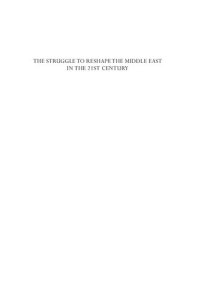
Ebook: The Struggle to Reshape the Middle East in the 21st Century
Author: Samer Shehata (editor)
- Year: 2023
- Publisher: Edinburgh University Press
- Edition: 1
- Language: English
- pdf
Examines how regional turbulence following the 2003 Iraq war and the 2011 Arab uprisings impacted domestic politics and regional policies of key states in the Middle East
- Contains detailed case studies based on original research and analysis by leading Middle East scholars
- Engages with the Middle East domestic politics and Middle East international relations scholarship
- A critical examination of US policy toward the Middle East under Obama and Trump
- Reinterpretation of Israel’s role within the Middle East regional order
- Detailed case study of Turkey’s foreign policy toward the Syria crisis
- Exploration of Iranian national security thinking and policy toward the Syria crisis
- Analysis of increased regional rivalry on the Gulf Cooperation Council and relations between member states
- Critique of international and regional discourses justifying intervention in Yemen and assessment of consequences
- Original research based on interviews examining role of regional actors in Egypt’s ‘failed democratization’
- Re-evaluation of the failure of Al Qaeda in Iraq and Syria
- First analysis of foreign policy orientation of the new Salafi parties in the region
The volume examines the causes and consequences of regional turbulence in the Middle East following the 2003 Iraq war and the 2011 Arab uprisings. The Middle East has experienced unprecedented levels of instability and violence during this period including regime breakdown, heightened rivalry and competition, civil and proxy wars, cross border military intervention, refugee flows, and the emergence of violent non-state actors.
Following a theoretical chapter analysing the drivers of regional turbulence, leading Middle East scholars investigate the impact of turbulence on the politics of different states and actors in the region. Nine case studies analyse the foreign policies and regional role of the United States and Israel, Iran and Turkey’s policies toward the Syrian crisis, and the impact of regional turbulence and intervention on Yemen, Egypt, and relations among Arab Gulf states. The two final chapters examine two new Islamist actors that emerged in the Middle East during this period: Sunni militant groups in Iraq and Syria and the new Salafi political parties and their foreign policy orientations.